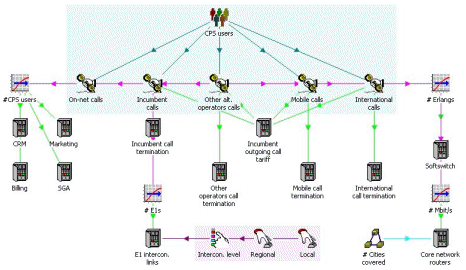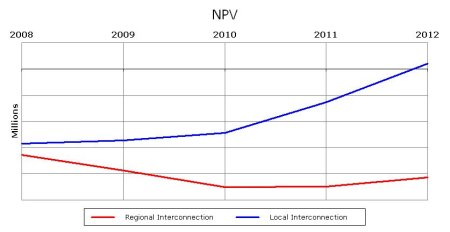 The Croatian fixed telecoms market is undergoing rapid liberalization, and the regulator
is faced with complex issues in attempting to encourage competition. This article
describes how Lator, a Croatian telecoms consultancy, has used STEM to build a bottom-up
model of the business of alternative operators using carrier pre-selection (CPS).
Sensitivity analysis was then used to identify the key drivers that influence the
profitability of the CPS business model - especially the level of the incumbent's
wholesale prices.
The Croatian fixed telecoms market is undergoing rapid liberalization, and the regulator
is faced with complex issues in attempting to encourage competition. This article
describes how Lator, a Croatian telecoms consultancy, has used STEM to build a bottom-up
model of the business of alternative operators using carrier pre-selection (CPS).
Sensitivity analysis was then used to identify the key drivers that influence the
profitability of the CPS business model - especially the level of the incumbent's
wholesale prices.
Regulating the Croatian telecommunications market
Croatia is an EU candidate state, expecting to become a member of the EU by 2011.
During the accession process, great efforts are being made to bring the Croatian
telecommunications market more in line with the EC regulatory framework. Although
the mobile market is considered to be liberalized and mature, liberalization of
the fixed market did not begin until 2005. Alternative operators began by offering
their services by wholesaling of the incumbent’s voice services through CPS, and
have now started to offer broadband services based on unbundled local loops. Broadband
penetration reached 8.5% of the population at the end of 2007, and there is great
potential for increase in the number of broadband lines, as well as increased market
share for alternative operators. 2008 is predicted to be a major milestone in the
Croatian fixed market, due to even stronger regulation of the market as well as
the expected conclusion of consolidation among alternative operators, which will
result in larger investments in the market.
The demanding process of liberalizing the fixed telecom market is the responsibility
of the national regulatory agency Hrvatska agencija za telekomunikacije (HAT). Given
the circumstances, HAT has made, within a short period of time since the end of
2004, a very good job, yet with a couple of issues that might lead to further regulatory
interventions.
Among others, the efficient supervision of the incumbent’s reference interconnection
and unbundling offers is a challenging task, considering the early phase of liberalization
and the frequently overvalued revenue expectations of the alternative operators,
which have been repeatedly complaining that the incumbent’s wholesale prices for
voice services do not allow them to reach a sufficient level of profitability.
The business model for CPS
In order to precisely determine the profitability level of the CPS wholesale option,
HAT ordered a study project from Lator. After analysing the options, Lator concluded
that the best way to precisely determine the profitability level would be to build
a bottom-up CPS business model, which would take into account all the relevant revenues
and costs faced by alternative operators. Such a model would be complex, needing
to take into account a large number of input elements, such as:
- call origination and call termination tariffs in different networks with peak and
off-peak alternatives
- various service bundles depending on customer type and region
- involvement of legacy TDM technology in the incumbent’s network, VoIP-based technology
in alternative operators’ networks.
Based on their previous experience with the STEM tool, Lator consultants
decided to use this tool for the construction of the model, fully aware that such
an approach would bring many advantages for the business-modelling process, compared
to the traditional practice of performing calculations in Excel tables.
The first phase of the project included the construction of a CPS model in STEM
(see Figure below), based on input data from the reference interconnection offers
of the incumbent and the three mobile operators. The rest of the input data comprised
market data related to the customer base and the price of telecom equipment.

Simplified view of the CPS business model in STEM
In the second phase of the project, Lator analysed the economic aspects of
the business model, which included EBIT and EBITDA margin calculations per year,
as well as NPV values over a five-year period. The results of the model were readily
gained through STEM’s Results module, based on pre-defined sets of tables and graphs
available within the tool.

NPV results for two interconnection scenarios
In order to provide HAT with options for future regulatory measures, Lator experts
identified the key drivers that influence the profitability of the CPS model by
performing sensitivity analysis. Thanks to STEM’s integrated sensitivity-analysis
module, the sensitivity results were easily produced, making it possible to determine
the quantitative influence that changes in the incumbent’s wholesale prices would
have on the CPS business model.
Clarity for the end user
Aside from the fact that this project has provided HAT with lots of benchmark data
that can be efficiently utilized in their daily regulatory work, our client was
also impressed by STEM’s ability to clearly consolidate a great amount of technical
and economic parameters, and to quickly introduce changes into a model and track
the corresponding results that these changes would cause.
It is also obvious that the STEM tool can be similarly applied in HAT for techno-economic
calculations related to issues in the fixed broadband market, such as local loop
unbundling and bitstream, which could soon require important regulatory measures
in order to further encourage competition.
 Tomislav
Majnaric is a Senior Consultant at Lator. Previously he worked for Ericsson in Croatia
and for the local partner of Lucent Technologies and Nortel Networks. He has undertaken
several telecoms consultancy projects in Croatia, and is currently working on projects
dealing with techno-economic analyses of technologies and business opportunities
in the local market.
Tomislav
Majnaric is a Senior Consultant at Lator. Previously he worked for Ericsson in Croatia
and for the local partner of Lucent Technologies and Nortel Networks. He has undertaken
several telecoms consultancy projects in Croatia, and is currently working on projects
dealing with techno-economic analyses of technologies and business opportunities
in the local market.
Lator is an independent Croatian telecommunications
consultancy firm whose mission is to provide expert and reliable support in the
further development of the Croatian telecommunications market.